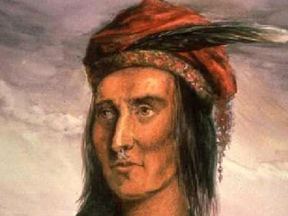'All of the wisdom that is held in the language unlocks the key to culture and history of the Munsee people'

Article content
A longtime Southwestern Ontario mystery about a towering historical figure is at the heart of a new project designed to pique the interest of those learning to speak an endangered Indigenous language.
Advertisement
Article content
Educator Ian McCallum, who grew up listening to relatives converse in their native language of Munsee on Munsee-Delaware Nation near London, has finished the translation of a 1931 London Free Press article about the death and burial of Shawnee chief Tecumseh – and the mystery surrounding it – into that little-spoken language.
“I did some digging and I thought this would be a really good story to translate,” said McCallum, who lives near Barrie. He’s one of about three or four people who speak fluent Munsee as a second language and he teaches about 50 beginners, he said.
“We were looking for community stories to translate into the Munsee language, and I started with my own family because COVID didn’t allow for a lot of communication with the elders.”
Advertisement
Article content
In the 1931 Free Press story, McCallum’s great-great uncle, Jacob Logan, described the death and burial of Tecumseh, who was killed near Chatham in 1813 while fighting for the British in the War of 1812.
The final location of Tecumseh’s body has long been debated, with some believing his corpse had been secretly disposed of by his own warriors. Logan, who died in 1935 at age 100, recounted in the article having overheard as a 14-year-old where Tecumseh was buried.
At that time, the Logan family’s cabin – which still stands in the Longwoods Conservation Area near Delaware – was visited by a group of War of 1812 veterans, including an Indigenous man named Jacob Fesson, McCallum said.
Logan’s mother told him to go upstairs but, recognizing the importance of their visit, told her son to keep his ears open.
Advertisement
Article content
Fesson told the story of Tecumseh’s death near Thamesville and how he and other Indigenous warriors had been instructed by the revered chief to hide his body from the enemy after he had been shot and wounded – an event he had foreseen in three dreams – during a battle.
The men used their tomahawks to dig a grave at the roots of a toppled tree and, once buried with his weaponry, the warriors covered it back up with the roots of the tree to avoid detection, Logan said.
Logan later attempted to find Tecumseh’s burial place.
“The topography of the land had changed so much from when he heard the story, so was unable to do so,” McCallum said.

McCallum, 50, is an education officer with the province’s Indigenous education office. He says many Munsees lost their language due to residential schools, where anything but English was prohibited.
Advertisement
Article content
The translated account, which will soon be made into an illustrated book, is designed to mark the start of the United Nations International Decade of Indigenous Languages, McCallum said. He hopes school boards and others will use it as a learning tool.
“All of the wisdom that is held in the language unlocks the key to culture and history of the Munsee people,” said McCallum, who also regularly tweets in Munsee under the user name @IanMcCallum3.
The Munsee people settled in southern Ontario after being pushed out of the east coast of the United States by colonists and settlers in the 1780s. McCallum’s ancestors settled on the Munsee-Delaware reserve, about 25 kilomeres southwest of London.
The son of an English immigrant father and Munsee-Delaware mother, McCallum split his time growing up between Munsee-Delaware and Barrie, where his father taught school.
Advertisement
Article content
After graduating from teachers college at Queen’s University, McCallum was required to take a course at Western University, which had just begun to teach the Mohawk language. After picking up a Munsee-English dictionary, he found a teacher at Moraviantown, another Munsee settlement in Chatham-Kent, and spent a couple of summers learning the language.
“I re-learned the language from that speaker,” said McCallum, who first learned to speak the language as a child.
Munsee is one of more than half a dozen Indigenous languages considered at risk in Southwestern Ontario. Others are:
- Oneida
- Ojibway
- Ottawa
- Mohawk
- Cayuga
- Onondaga
- Seneca
- Cree
HRivers@postmedia.com
No comments:
Post a Comment